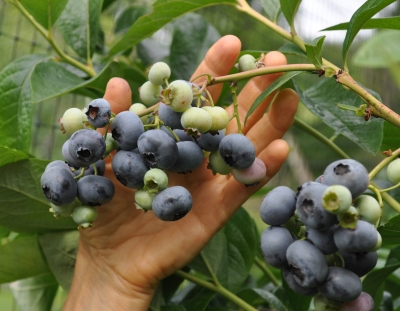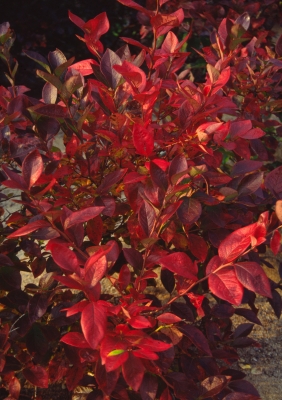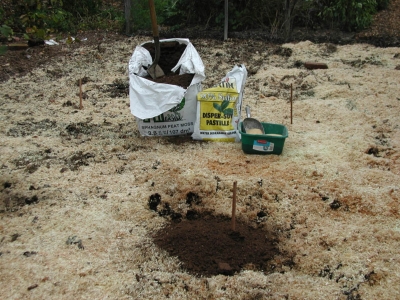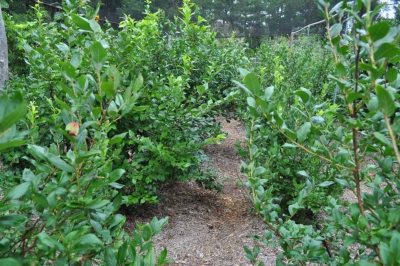BLUEBERRIES OUTSIDE, APHIDS INSIDE
Plant the Best-Tasting Fruit
My sixteen blueberry plants keep me in blueberries year ‘round, so I’m not planting any this year. But you are, or should be. The bushes are attractive in every season, with white blossoms in spring, foliage that looks spry all summer and turns crimson red in fall, and stems that shade to red in winter. The bushes are almost pest-free. And the berries are healthful and delicious.

 All you would-be blueberry planters out there: Pay attention to the soil for your plants, about which I’m going to offer advice. Too many people plunk a blueberry bush into a hole dug in their lawn and then wonder about the lack of berries. Poor growth, that’s why. The plants bear fruit on one year old stems. If shoots grow only a few inches one year, there’s little room on which to hang berries the following year.
All you would-be blueberry planters out there: Pay attention to the soil for your plants, about which I’m going to offer advice. Too many people plunk a blueberry bush into a hole dug in their lawn and then wonder about the lack of berries. Poor growth, that’s why. The plants bear fruit on one year old stems. If shoots grow only a few inches one year, there’s little room on which to hang berries the following year.
Taking a cue from wild blueberries, here’s what the bushes need, soil-wise: acidity (pH 4-5.5), organic matter, relatively low fertility, moisture, air, and no competition from weeds. For starters, check the soil pH with either a home testing kit or by taking a sample to a Cooperative Extension office or soil testing laboratory. If soil is not sufficiently acidic, add sulfur, preferable pelletized sulfur for ease of handling, 3⁄4 pound of sulfur per 100 square feet in sandy soils or three times this amount in heavier soils, for each pH unit the soil is above 4.5. Contrary to popular myth, adding oak leaves or pine needles will NOT do the trick. Spread sulfur over the ground as far as the eventual spread of the roots, which is about 3 feet in all directions.
Then dump a bucketful of peat moss right where you plan to dig each hole. Dig the hole deep and twice as wide as needed to get the plant in the ground, mixing the peat moss with the soil. Peat moss provides a long-lasting source of organic matter, which also helps with aeration and water retention.
Finally, plant and water.
Wait, you’re not finished yet. Right after planting, spread some organic mulch, such as wood shavings, leaves, or pine needles, a couple of inches deep and as wide a spread as the roots. Mulch keeps the soil moist and further enriches the ground with organic matter as its lower layers decompose.
Soil & Birds
Ongoing soil care for blueberry bushes is simple and necessary, mostly food and drink.
Assuage the bushes’ thirst with, barring rain, three-quarters of a gallon of water per week for each square foot spread of the roots. Satisfy their hunger by spreading a high nitrogen fertilizer late each fall. I use an organic fertilizer, such as soybean or alfalfa meal, at the rate of 1.5 pounds over every hundred square feet of root spread. These fertilizers offer nitrogen throughout the growing season in a form blueberries can use.
Periodically re-check the soil pH and add more sulfur, if needed. Replenish the mulch each fall, laying the new mulch right on top of the old mulch.
For the future — harvest of first berries should begin within a couple of years — think about birds. Are you going to share? Are they going to share? I opt not to share, enclosing my whole planting in netting, to create a walk-in “blueberry temple.”
Aphid Attack & Counterattack
Turning inward, not introspectively, but to the greenhouse, I see aphids getting a foothold. Their populations soared a few weeks ago as young and old feasted on aging celery and arugula plants beginning to send up seed stalks.
My first counterattack was to cut down or dig up these old plants and whisk them to the compost pile before too many insects dropped off to take up residence on smaller plants and seedlings. Not that there weren’t plenty of stragglers fattening up on younger plants.
My tack with the stragglers has been to set my watering wand on “fan spray” and blast the plants with water. Most aphids that get knocked off plants don’t return. I spray on mornings of sunny days so leaves dry relatively quickly, limiting potential disease problems. The temporary increase in humidity might increase the likelihood of aphids’ getting fungal diseases, to which they are very susceptible.
Of less effect are the ladybugs I periodically introduce into the greenhouse, in large part because I don’t have enough of them. They used to enter my home in large numbers via leaks around an old, south-facing window and nearby crack in the wall. I’d merely vacuum them up as they clustered on the window pane and shake the contents of the hand-held vacuum among plants in the greenhouse late in the day. That window and the wall crack have been repaired, so few ladybugs end up indoors.
I’m considering making a hole in the wall to let the ladybugs indoors again and hanging a ladybug live trap (available commercially or made from online plans at http://www.ars.usda.gov/is/br/lbeetle/001030.trap.pdf) right near the hole.
Thus far, though, cleanup and water sprays have kept aphids under control, and plants are growing well. Once transplanted outdoors aphid problems vanish because of the weather and natural predators.




Is there any time that’s too close to planting for adding sulfur? I have blueberries arriving in 2 weeks, and my soil test shows 6.5 right now.
No problem with adding sulfur at any time. Now would be good.
What do you think of growing blueberries in large containers and following your same advice? Is it worth the cost/trouble to grow them in containers (due to lack of space)?
Blueberries can be grown in large containers, but it’s more trouble than in the ground. A plant in a container would take up about the same amount of space as one in the ground, so why not just plant it in the ground?
Totally unrelated, Lee, but since you have a greenhouse and an affinity for rare fruits, have you tried growing Indian gooseberry? If so, what’s your experience been? I just ordered a shipment of 100 seeds and hopefully I can get most of them to germinate so I can test them out for myself.
I never heard of Indian gooseberry. Wiki says the fruit is “sour, bitter and astringent, and it is quite fibrous” so I can’t say that I’m, all that interested in trying it. Have you tasted it?
Thanks for the tips, Lee! Do you have favorite varieties? I’m in WI, so a similar climate to yours.
Yes, many favorites. Of which vegetables?
I currently have purchased only one blueberry bush and a friend has now told me that I need another one of a different variety for trans-pollination. Is this correct?
Blueberries will bear on their own, but by having a different variety nearby, you’ll get more and bigger berries. The plants are partially self-fertile.
I’m wondering if we should dig up our blue berry’s and treat the soil then plant then again. They’ve been in the same place for 3 years, not doing well. Or dig up around the roots and acidify the soil. We have around 12 bushes I believe. Tired of them not producing.
As long as drainage is good, I don’t think digging up is necessary. Right away, spread the required amount of sulfur on the ground well beyond the spread of the roots. In late fall, spread some soybean meal (2 pounds/100 sq. ft.) or other organic fertilizer to give the equivalent amount of nitrogen, then top is with 3 inches of mulch. Water, as needed, next year, and your blueberries should take off!